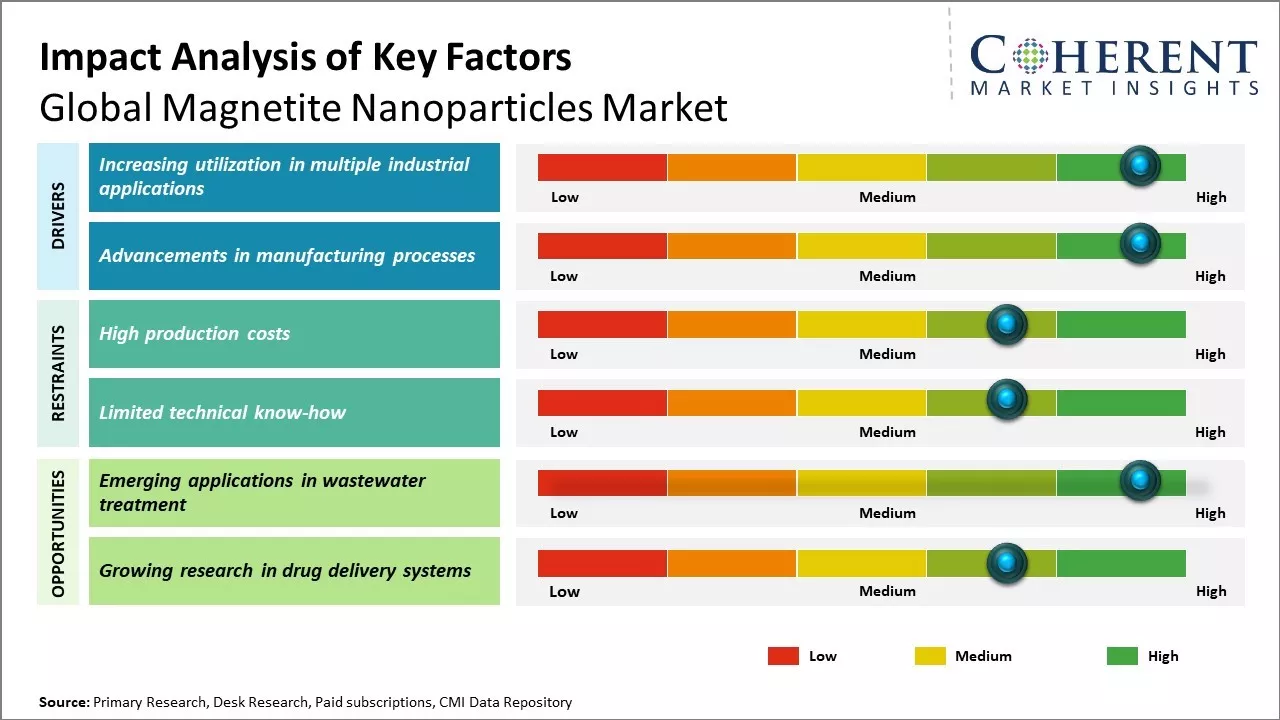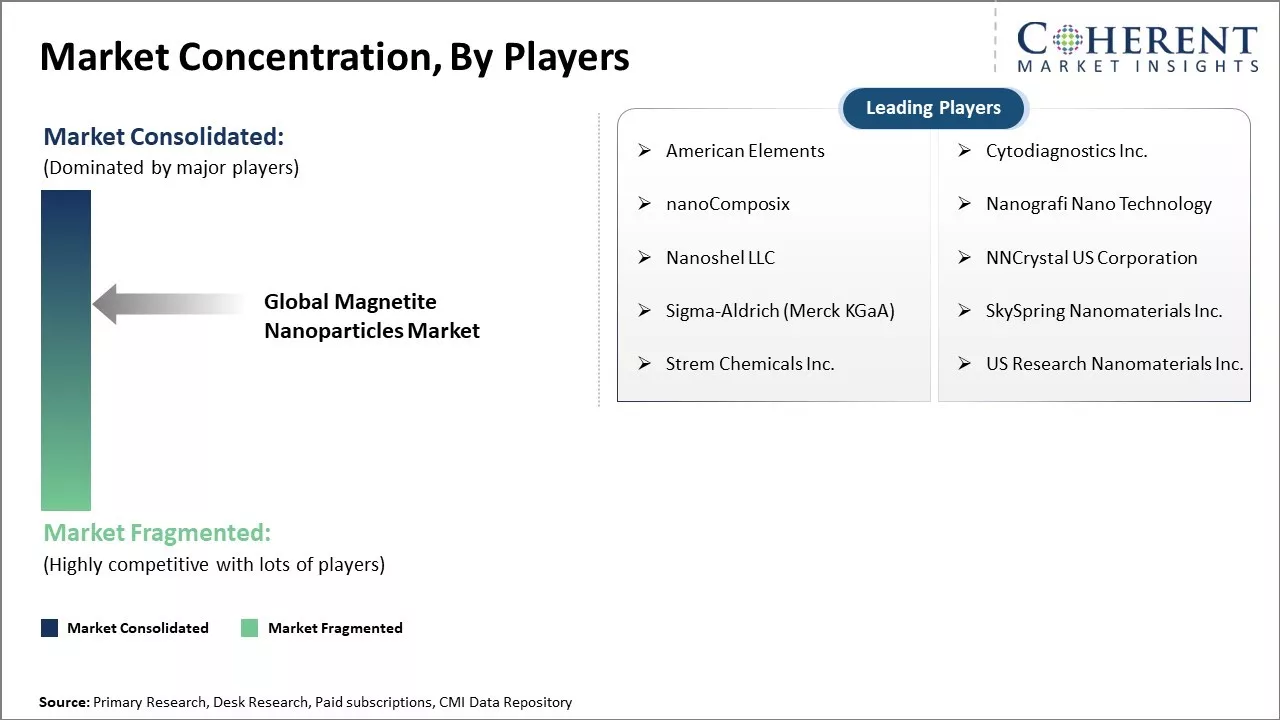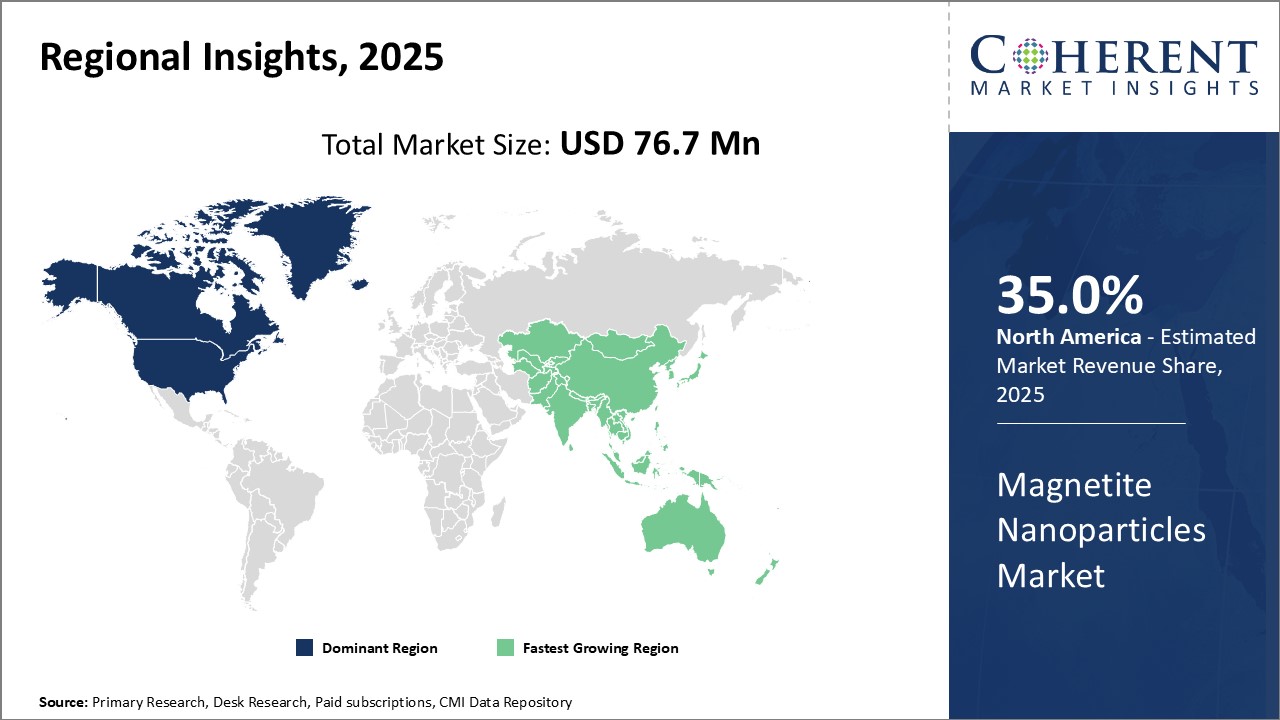The magnetite nanoparticles market size is estimated to be valued at USD 76.7 Mn in 2025 and is expected to reach USD 148.5 Mn by 2032, exhibiting a compound annual growth rate (CAGR) of 9.9% from 2025 to 2032.

To learn more about this report, Download Free Sample
The magnetite nanoparticles market is anticipated to witness consistent growth due to their increasing application in biomedical applications, environmental remediation, and electronics. Increasing demand for sophisticated diagnostic tools, targeted drug delivery systems, and magnetic resonance imaging (MRI) contrast agents will fuel demand, primarily from the healthcare industry.
Magnetite nanoparticles in the biomedical sector offer better magnetic properties, biocompatibility, and surface modification properties, hence are suitable for research and clinical applications. Their application in pollutant removal and wastewater treatment also supports adoption in the environmental segment.
However, high production costs, regulatory hurdles to nanomaterial safety, and potential toxicity concerns may be challenges to wider commercialization. Despite these restraints, research, government backing, and expanding applications across sectors are anticipated to offer significant growth prospects to the magnetite nanoparticles market through 2032.

To learn more about this report, Download Free Sample
|
Current Events |
Description and its impact |
|
Growth in Biomedical Nanotechnology Investments |
|
|
Advancements in Magnetite Nanoparticles for Environmental and Biomedical Applications |
|
Uncover macros and micros vetted on 75+ parameters: Get instant access to report
Magnetite nanoparticles are becoming increasingly integral to the evolution of modern electronics and data storage technologies due to their excellent magnetic, electrical, and size-dependent properties. They possess high saturation magnetization and nanoscale tunability that make them very suitable for applications in magnetic storage devices, like hard drives and tapes, where high data density is required. Moreover, they are central elements in magneto resistive sensors and spintronic devices, which are based on electron spin control for low-power and high-speed data processing. For instance, in November 2024, Tohoku University researchers investigated cobalt-manganese-iron alloy thin films with high perpendicular magnetic anisotropy, essential for fabricating MRAM devices using spintronics. New breakthroughs have also made their integration into flexible electronics possible, enabling devices to retain magnetic function even under bending or stretching. These developments attest to the expanding role of magnetite nanoparticles in facilitating the next generation of small, robust, and energy-saving electronic systems.
The magnetite nanoparticles market is experiencing strong momentum, driven by the global surge in funding for nanomaterials research and the expansion of collaborative academic-industry partnerships. Governments and institutions across the U.S., Europe, and Asia are making strategic investments in advanced nanotechnology initiatives. Magnetite nanoparticles, in particular, are gaining attention for their versatility in biomedicine, environmental remediation, energy storage, and electronics.
This rise in funding is often paired with university-led research programs and public-private partnerships that accelerate lab-to-market transitions. These collaborations are instrumental in securing patents, initiating pilot-scale projects, and fostering technology transfer that supports commercialization.
A key example is the U.S. National Nanotechnology Initiative (NNI), whose FY2025 budget supplement emphasizes robust investments in collaborative nanotech research infrastructure—explicitly highlighting materials like magnetite nanoparticles as priority areas for future development.
The increasing threat of handling growing amounts of industrial and municipal wastewater poses a valuable opportunity for the magnetite nanoparticles market. With growing world populations and accelerating industrialization, efficient, sustainable, and scalable technologies for water treatment are more sought after than ever before. Magnetite nanoparticles have the potential to be an optimal solution as they possess specific magnetic and surface adsorption properties.
These nanoparticles can be added to wastewater streams, where they selectively adsorb toxic heavy metals, dyes, and other pollutants. Their high magnetic responsiveness makes it simple and quick to separate them from the treated water using external magnetic fields—a process that is quicker and more efficient than traditional chemical treatments. In contrast to conventional processes, this process generates little secondary waste, obviates the use of aggressive reagents, and lowers operational costs considerably. While ecological rules become stringent and green technologies make their entrance, magnetite nanoparticle remediation solutions have a promising place in the water treatment future ahead.
In terms of application, the biomedical segment is expected to contribute 76.0% share of the market in 2025, due to increasing demand for targeted drug delivery. Magnetite nanoparticles functionalized with antibodies or drugs can be guided to diseased sites such as tumors using an external magnet. This targeted delivery allows for higher concentrations of drugs to accumulate in tumors while minimizing systemic exposure and side effects. Consequently, magnetite nanoparticles are being widely evaluated as drug carriers for cancer therapies.
Another key application driving the biomedical segment is the hyperthermia treatment for cancer. Magnetite nanoparticles generate heat when exposed to an alternating magnetic field. This phenomenon of magnetic hyperthermia, where nanoparticles raise the temperature of tumor tissue to over 41°C, is being researched for the treatment of various cancers. The localized heat damage can inhibit tumor growth with minimal effects on healthy tissues. Ongoing clinical trials are exploring the potential of magnetic hyperthermia to complement chemotherapy and radiation therapy.
The intrinsic properties of magnetite nanoparticles, such as biocompatibility, magnetic properties, and tunable surface chemistry, have led to numerous nanomedicine applications. Both academic researchers and companies are actively developing advanced nanomedicine formulations using magnetite nanoparticles for applications like biosensing, bioimaging, and tissue engineering. This widespread research interest is anticipated to translate into new product approvals and commercial opportunities, thus propelling the future growth of the biomedical segment within the magnetite nanoparticles market.

To learn more about this report, Download Free Sample
North America is set to lead the global magnetite nanoparticles market in 2025, with a market share of about 35.0%. This dominance is supported by strong R&D environment, sophisticated healthcare infrastructure, and tight environmental laws. The U.S. and Canada are home to multiple first-rate research universities, nanotechnology start-ups, and biomedical firms that are pioneering magnetite nanoparticle application areas ranging from targeted drug delivery and MRI imaging contrast agents to environmental cleanup and high-end electronics.
Researchers discovered the potential use of zinc/cerium-substituted magnetite nanoparticles as tools for biomedical research in 2023. Such altered particles possessed improved attributes viable for specific drug delivery and imaging, making these promising in areas of cancer treatment and diagnostic interventions.
Furthermore, North America's high environmental standards and emphasis on sustainable industrial practices are driving the use of green technologies, in which magnetite-based technologies are highly efficient and environmentally friendly.
The Asia Pacific region has become one of the fastest-growing magnetite nanoparticles markets, fueled by fast industrialization, growing healthcare infrastructure, and increasing environmental issues. China, India, Japan, and South Korea are at the forefront, heavily investing in nanotechnology research and development. These countries are increasingly incorporating magnetite nanoparticles into water treatment facilities, biomedical devices, and electronics production to meet local and international demand.
Increasing pollution rates and water shortages in highly congested urban areas have created the need for sophisticated wastewater treatment technologies, where magnetite nanoparticles serve to remove contaminants. Moreover, government policies to enhance the use of nanotechnology—like China's "Made in China 2025" initiative and India's Nano Mission—have served to support scholar-industry collaborations, further fueling R&D expenditures.
Asia Pacific's cost-effective manufacturing potential, along with its vast talent pool and accommodating policy environments, make the region a prime hub for both commercialization and innovation in the magnetite nanoparticles industry.
The U.S. magnetite nanoparticles market is witnessing impressive growth, fueled by advances in biomedical research, environmental cleanup activities, and government support schemes. During 2022 to 2025, a number of developments have highlighted the nation's leadership position in this market.
In 2022, scientists synthesized magnetite nanoparticles with biodegradable zwitterionic polymers coating, producing multifunctional nanocomposites for drug delivery and cancer therapy. The nanocomposites showed improved biocompatibility and targeted delivery efficiency, being a giant leap in nanomedicine.
The U.S. Environmental Protection Agency (EPA) started a project dealing with magnetic nanocomposites for water purification. The project involves the synthesis of composites of magnetic nanoparticles linked to bacterial metalloproteins, which provide a new solution for purifying drinking water from heavy metals, especially in tribal and underprivileged communities.
High-purity magnetite nanoparticles used in drug delivery, hyperthermia treatment, and MRI contrast agents typically range from US$ 800 to US$ 3,500 per gram, depending on surface functionalization (e.g., PEGylation, silica coating), particle size uniformity, and biocompatibility grade.
Lower-grade magnetite nanoparticles used for heavy metal adsorption, dye removal, or catalytic oxidation are less expensive, generally priced between US$ 50 to US$ 300 per kilogram.
These are produced in bulk and may include some impurities or uncoated forms suitable for large-scale applications where biocompatibility is not essential.
High-performance nanoparticles designed for magneto-optical devices, sensors, or magnetic inks typically fall within the US$ 500 to US$ 1,800 per 100 grams range.
Their pricing depends on particle morphology, crystallinity, and batch-to-batch consistency, which are critical for electronic integration.
Lab-scale synthesis of magnetite nanoparticles may require autoclaves, magnetic stirrers, and inert gas handling systems.
Initial setup for small labs may range from US$ 10,000 to US$ 50,000, while pilot-scale reactors for commercial production can exceed US$ 250,000, depending on automation level and throughput.
Routine particle size analysis (e.g., DLS, TEM), surface charge (zeta potential), and purity (XRD, FTIR) require ongoing operational expenses.
These include instrument maintenance (US$ 1,000–5,000/year) and consumables (e.g., solvents, standards) estimated at US$ 500 to US$ 2,000/year depending on testing frequency.
For biomedical applications, compliance with GMP, ISO, and biocompatibility standards may add US$ 20,000 to US$ 100,000 per year for audits, certifications, and third-party testing, depending on the target market.
| Report Coverage | Details | ||
|---|---|---|---|
| Base Year: | 2024 | Market Size in 2025: | USD 76.7 Mn |
| Historical Data for: | 2020 To 2024 | Forecast Period: | 2025 To 2032 |
| Forecast Period 2025 to 2032 CAGR: | 9.9% | 2032 Value Projection: | USD 148.5 Mn |
| Geographies covered: |
|
||
| Segments covered: |
|
||
| Companies covered: |
American Elements, Cytodiagnostics Inc., nanoComposix, Nanografi Nano Technology, Nanoshel LLC, NNCrystal US Corporation, Sigma-Aldrich (Merck KGaA), SkySpring Nanomaterials Inc., Strem Chemicals Inc., and US Research Nanomaterials Inc. |
||
| Growth Drivers: |
|
||
| Restraints & Challenges: |
|
||
Uncover macros and micros vetted on 75+ parameters: Get instant access to report
CMI Data Analytics Tool, and Proprietary CMI Existing Repository of Information for Last 8 Years
Share
Share
About Author
Yash Doshi is a Senior Management Consultant. He has 12+ years of experience in conducting research and handling consulting projects across verticals in APAC, EMEA, and the Americas.
He brings strong acumen in helping chemical companies navigate complex challenges and identify growth opportunities. He has deep expertise across the chemicals value chain, including commodity, specialty and fine chemicals, plastics and polymers, and petrochemicals. Yash is a sought-after speaker at industry conferences and contributes to various publications on topics related commodity, specialty and fine chemicals, plastics and polymers, and petrochemicals.
Missing comfort of reading report in your local language? Find your preferred language :
Transform your Strategy with Exclusive Trending Reports :
Frequently Asked Questions
Joining thousands of companies around the world committed to making the Excellent Business Solutions.
View All Our Clients